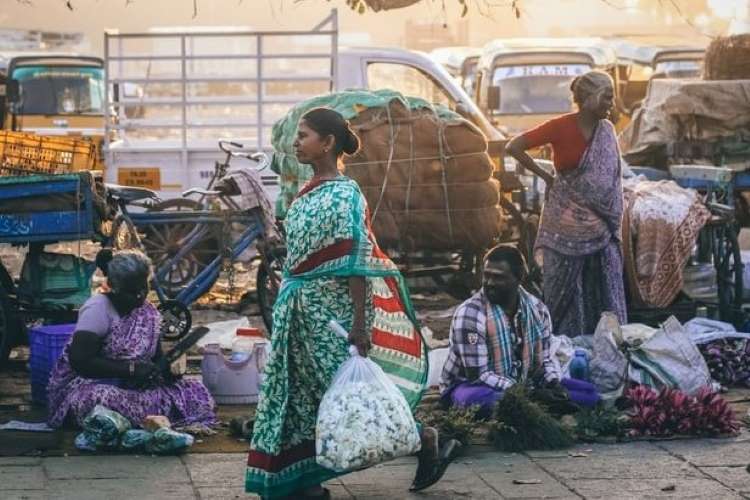
Multidimensional Poverty Index 2023: In its 75 years as an independent nation, India has achieved remarkable feats, including joining the exclusive club of nations that have successfully landed spacecraft on the moon and Mars. However, one significant challenge that remains is the eradication of poverty. The fact that one in seven Indians continues to experience poverty across multiple dimensions is a cause of concern for policymakers in this young nation. While India has experienced a decline in the number of multidimensionally poor individuals, there remains a huge disparity between the rich and the poor, and malnutrition remains a key area for worry, says a report by government think tank Niti Aayog.
While poverty is perceived simply as lack of money, the poor themselves consider their experience of poverty much more broadly as they can suffer multiple disadvantages at the same time. This ranges from poor health or malnutrition, lack of access to clean water and electricity, poor quality of work or little education. Focusing solely on one aspect, such as income, when formulating poverty alleviation policies cannot fully capture the complexity of the problem. Multidimensional poverty sheds light not only on who is poor but also how they experience poverty.
READ | Global Food Regulators Summit seeks to tackle non-communicable diseases
The second edition of Multidimensional Poverty Index (MPI) captures overlapping deprivations in health, education, living standards and other broader qualitative aspects of life like child mortality and housing conditions to ascertain multidimensional poverty. The primary data source for the same was National Family Health Survey-5 (NFHS-5).
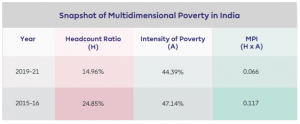
What does the report say
First the good numbers. In 2015-16, 24.85% individuals fell in the multidimensionally poor category but the same was lower at 14.96% in 2019-2021. The number of states with less than 10% people living in multidimensional poverty also doubled in the five years between 2016 and 2021. In a consolidated figure, approximately 13.5 crore Indians escaped poverty between the five-year period. This is owing to the improvements in indicators like access to cooking fuel, sanitation, drinking water, and bank accounts, among others, the report titled ‘National Multidimensional Poverty Index: A Progress Review 2023’ said.
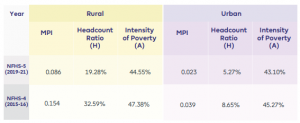
Also, poverty in rural areas witnessed the fastest decline from 32.59% to 19.28%, as states like Bihar, Uttar Pradesh, Madhya Pradesh, Odisha, and Rajasthan made strides in improving across multiple indicators. Except for Bihar, no other state in India has more than one-third of its population living in multidimensional poverty.
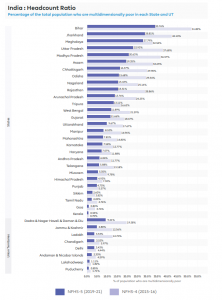
Now, 14 states have less than 10% of the population living below the poverty line. It includes Mizoram, Himachal Pradesh, Punjab, Sikkim, Tamil Nadu, Goa, Kerala, Telangana, Andhra Pradesh, Haryana, Karnataka, Maharashtra, Manipur, and Uttarakhand. This is not to say that the wide disparity between the number of poor in urban and rural areas has been bridged.
Coming to the not-so-cheerful parts, there has been a marginal improvement in indicators such as nutrition and access to education and these parameters contributed the most in keeping one in seven Indians multidimensionally poor. To gauge multidimensional poverty, Niti Aayog weighs three main indicators viz standard of living, health, and education. However, it has been found that reduction is not equally represented in these indicators i.e. progress in unequal.
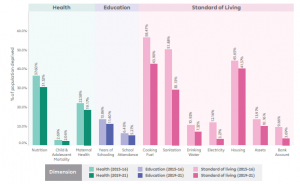
For the broad health category, three sub-indicators namely nutrition, child and adolescent mortality, and maternal health showed only moderate improvement, the report showed. There is an abysmal lack of proper nutrition which contributed close to 30% in the overall calculation of India’s multidimensional poverty index. With a one-third weightage in the multidimensional poverty in India, nutrition is arguably one of the most important indicators in India’s national MPI, the report said. A woman or a man is considered undernourished if their Body Mass Index (BMI) is below 18.5 kg/m2. Even if a single member of the household is identified as undernourished, the entire household is treated as deprived of nutrition.
A significant improvement was also found missing in other indicators viz lack of years of schooling (16.65%), inadequate access to maternal health services (11.73%), and less-than-desired school attendance (9.10%), among others. A lack of cooking fuel to close to 44% of India’s population and more than 30% of the population lacking sanitation services is another area of concern. 41% Indians still lack housing. This has dipped from 46% in 2015-16.
For each of the above-mentioned indicators, India has a massive national programme to ensure coverage and access. For instance, the Swachh Bharat Mission was rolled out with much fanfare and India became open defecation free in October, 2019. Similarly, the Pradhan Mantri Awas Yojana (PMAY) rolled out seven years ago aimed to house every Indian in a pucca dwelling by 2022.
Tackling multidimensional poverty
While India has achieved rapid poverty reduction by focussing on seven standard-of-living sub-indicators namely cooking fuel, sanitation, drinking water, housing, electricity, assets, and bank accounts, more work is needed in health and education indicators. Going ahead, increased government spending on health and education, is key to further poverty reduction especially when poverty elimination is also at the core of India’s development agenda.
The data from the NITI Aayog report is in line with the findings of the UNDP Global Multidimensional Poverty Index, which showed that more than a third of India’s poor were pushed out of multidimensional poverty between 2005 and 2021. India is on track to achieve the SDG target of reducing multi-dimensional poverty by at least half much ahead of 2030.
Prachi Gupta is an Assistant Editor with Policy Circle. She is a post graduate in English Literature from Lady Shri Ram College For Women, Delhi University. Prachi started her career as a correspondent with financialexpress.com. She specialises in policy impact studies.

